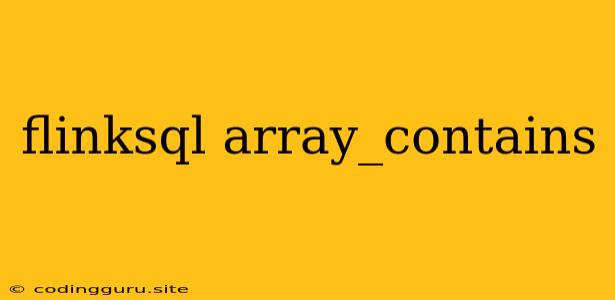Unlocking the Power of array_contains in Flink SQL
Flink SQL, the powerful SQL dialect for Apache Flink, provides a rich set of functions for manipulating data. One such function, array_contains, proves invaluable when working with arrays within your data. This article delves into the intricacies of array_contains and explores how you can leverage it to perform powerful data analysis.
What is array_contains?
As its name suggests, array_contains is a function that determines whether a given element exists within an array. This function simplifies the process of checking for specific values inside arrays, enhancing the efficiency of your Flink SQL queries.
Why use array_contains?
Imagine you have a table containing user profiles, where each user has an array of interests. You need to find users interested in "sports." array_contains comes to the rescue by enabling you to quickly filter users whose interest array includes "sports."
How to use array_contains
The syntax for array_contains is straightforward:
array_contains(array, element)
Parameters:
- array: The array to be searched.
- element: The value you are searching for within the array.
Return Value:
array_contains returns a boolean value:
- TRUE: If the
elementis found within thearray. - FALSE: If the
elementis not found within thearray.
Examples
Let's illustrate the usage of array_contains with a few examples:
Example 1: Basic Usage
SELECT * FROM users
WHERE array_contains(interests, 'sports');
This SQL query retrieves all users whose interests array includes "sports."
Example 2: Filtering with Multiple Elements
SELECT * FROM users
WHERE array_contains(interests, 'sports') AND array_contains(interests, 'music');
This query retrieves users interested in both "sports" and "music."
Example 3: Working with Nested Arrays
SELECT * FROM user_events
WHERE array_contains(event_details.tags, 'concert');
In this example, event_details is a nested object containing an array of tags. array_contains helps us find events with the "concert" tag.
Beyond Simple Checks
The power of array_contains extends beyond simple existence checks. You can utilize it in conjunction with other Flink SQL functions for more advanced filtering and analysis:
1. Conditional Filtering:
SELECT * FROM users
WHERE CASE
WHEN array_contains(interests, 'sports') THEN 'Sporty'
WHEN array_contains(interests, 'music') THEN 'Music Lover'
ELSE 'Other'
END = 'Sporty';
This example demonstrates how you can use array_contains within a CASE expression for more complex filtering based on array values.
2. Aggregation:
SELECT
COUNT(DISTINCT user_id),
SUM(CASE WHEN array_contains(interests, 'sports') THEN 1 ELSE 0 END) AS sport_count
FROM users;
This example aggregates user data, calculating the total number of users and the number of users interested in "sports."
Conclusion
The array_contains function in Flink SQL is a valuable tool for working with data containing arrays. Its simplicity and flexibility allow for efficient filtering, conditional logic, and aggregation based on array elements. By mastering the use of array_contains, you can unlock a new level of data analysis power within Flink SQL.
